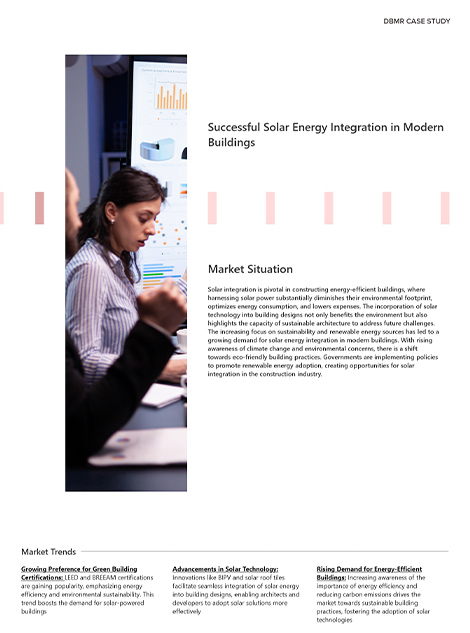Market Situation
Solar integration is pivotal in constructing energy-efficient buildings, where harnessing solar power substantially diminishes their environmental footprint, optimizes energy consumption, and lowers expenses. The incorporation of solar technology into building designs not only benefits the environment but also highlights the capacity of sustainable architecture to address future challenges. The increasing focus on sustainability and renewable energy sources has led to a growing demand for solar energy integration in modern buildings. With rising awareness of climate change and environmental concerns, there is a shift towards eco-friendly building practices. Governments are implementing policies to promote renewable energy adoption, creating opportunities for solar integration in the construction industry.
Market Trends
- Growing Preference for Green Building Certifications: LEED and BREEAM certifications are gaining popularity, emphasizing energy efficiency and environmental sustainability. This trend boosts the demand for solar-powered buildings
- Advancements in Solar Technology: Innovations like BIPV and solar roof tiles facilitate seamless integration of solar energy into building designs, enabling architects and developers to adopt solar solutions more effectively
- Rising Demand for Energy-Efficient Buildings: Increasing awareness of the importance of energy efficiency and reducing carbon emissions drives the market towards sustainable building practices, fostering the adoption of solar technologies
Challenges faced by client in Integrating Solar Energy into Construction Projects
- Sustainability Challenges: Meeting sustainability goals poses challenges due to the need for environmentally friendly construction practices and materials, along with energy-efficient building designs
- Cost-Effectiveness Concerns: Balancing sustainability with cost-effectiveness is crucial, as integrating solar energy solutions may require significant upfront investments, potentially impacting overall project budgets
- Architectural Aesthetics: Maintaining architectural aesthetics is essential for construction projects, as solar panels and energy-efficient features must seamlessly blend with the building's design to preserve its visual appeal
- Innovative Solutions: Innovative approaches are necessary to address these challenges, such as incorporating solar technologies into building materials, optimizing energy storage systems, and utilizing advanced design techniques
- Energy Efficiency Integration: Efficiently integrating solar energy into building designs involves implementing passive design strategies, optimizing building orientation, and utilizing high-performance building materials to minimize energy consumption
DBMR Approach
Our research firm conducts a comprehensive analysis of the client's requirements, market trends, and technological advancements in solar energy integration. We assess the feasibility of various solar energy solutions, considering factors such as building orientation, energy consumption patterns, and budget constraints. Our approach involves collaborating closely with architects, engineers, and renewable energy experts to develop customized solar solutions tailored to the client's specific needs.
DBMR Recommendations
- Building-Integrated Photovoltaics (BIPV): BIPV systems are designed to merge with the building's architectural elements, such as facades, windows, and roofs, effectively integrating solar energy generation into the structure itself. This integration ensures that the building maintains its aesthetic appeal while harnessing solar energy efficiently. By incorporating BIPV, buildings can contribute to renewable energy generation without compromising on design
- Solar Roof Tiles: Solar roof tiles offer a discreet and visually appealing alternative to traditional solar panels. These tiles are designed to mimic the appearance of conventional roofing materials, seamlessly blending with the overall architecture of the building. This allows for the integration of solar energy generation without imposing a visual disruption, thus enhancing the building's aesthetic appeal. Additionally, solar roof tiles provide a practical solution for buildings where traditional solar panels may not be feasible due to design constraints or aesthetic considerations
Business Impact of Embracing Solar Energy Solutions.
- Cost Savings on Energy Bills:
- By installing solar energy solutions, the client can generate their own electricity, reducing reliance on grid power
- Solar power is a renewable resource, meaning once the initial investment is made, the energy generated is essentially free, leading to long-term cost savings
- Through net metering or feed-in tariffs, excess electricity generated can be sold back to the grid, further offsetting energy costs
- Carbon Footprint Reduction:
- Solar energy is a clean, renewable energy source that produces no greenhouse gas emissions during operation
- By switching to solar power, the client can significantly reduce their reliance on fossil fuels for electricity generation, thus lowering their carbon footprint
- This aligns with environmental sustainability goals and demonstrates a commitment to combating climate change
- Enhanced Brand Reputation as a Sustainability Leader:
- Embracing solar energy solutions showcases the client's commitment to sustainability and environmental stewardship
- Being perceived as a leader in sustainability can enhance the client's reputation within the construction industry and among consumers
- It may attract environmentally conscious customers, employees, and investors who prioritize sustainability in their decision-making
- Increased Property Value and Marketability:
- Buildings with integrated solar energy systems have higher property values due to reduced operating costs and potential revenue generation from excess energy sales
- Solar-equipped properties are attractive to tenants seeking energy-efficient, sustainable spaces, leading to higher occupancy rates and rental premiums
- The marketability of the property is enhanced, as it aligns with growing consumer preferences for eco-friendly and energy-efficient buildings
By considering these factors, the adoption of solar energy solutions presents numerous benefits for the client, ranging from financial savings and environmental impact to brand reputation and property value enhancement.
Conclusion
Successful solar energy integration in modern buildings offers numerous benefits, including energy efficiency, cost savings, and environmental sustainability. By leveraging innovative solar technologies and collaborating with experienced renewable energy partners, construction firms can overcome challenges and capitalize on the growing demand for sustainable building practices. Implementing solar energy integration not only aligns with regulatory requirements and market trends but also demonstrates a commitment to creating healthier, more eco-friendly built environments for future generations.
